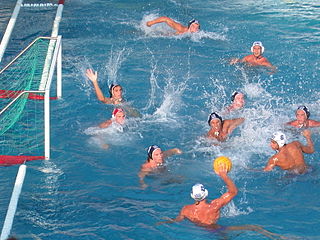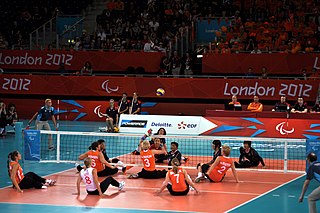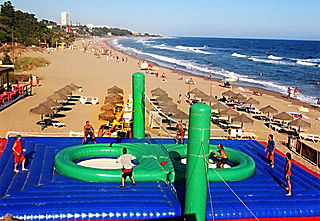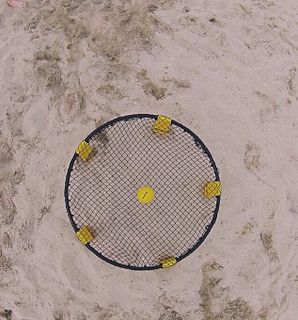
Volleyball is a team sport in which two teams of six players are separated by a net. Each team tries to score points by grounding a ball on the other team's court under organized rules. It has been a part of the official program of the Summer Olympic Games since Tokyo 1964. Beach volleyball was introduced to the programme at the Atlanta 1996. The adapted version of volleyball at the Summer Paralympic Games is sitting volleyball.

Water polo is a competitive team sport played in water between two teams of seven players each. The game consists of four quarters in which the teams attempt to score goals by throwing the ball into the opposing team's goal. The team with the most goals at the end of the game wins the match. Each team is made up of six field players and one goalkeeper. Excluding the goalkeeper, players participate in both offensive and defensive roles. It is typically played in an all-deep pool where players cannot touch the bottom.

Beach volleyball is a team sport played by two teams of two or more players on a sand court divided by a net. Similar to indoor volleyball, the objective of the game is to send the ball over the net and to ground it on the opponent's side of the court. Each team works in unison to prevent the opposing team from grounding the ball on their side of the court.

Sporting equipment, also called sporting goods, are the tools, materials, apparel, and gear used to compete in a sport and varies depending on the sport. The equipment ranges from balls, nets, and protective gear like helmets. Sporting equipment can be used as protective gear or a tool used to help the athletes play the sport. Over time, sporting equipment has evolved because sports have started to require more protective gear to prevent injuries. Sporting equipment may be found in any department store or specific sporting equipment shops.
Basketball moves are generally individual actions used by players in basketball to pass by defenders to gain access to the basket or to get a clean pass to a teammate to score.

U.S. Championship V'Ball, also known simply as V'Ball, is a 1988 beach volleyball sports game released for the arcades by Technōs Japan Corporation. The arcade version was distributed in North America by Taito. A Nintendo Entertainment System version was published by Nintendo, in North America and the PAL region, under the title of Super Spike V'Ball.
A trick play, also known as a gadget play, gimmick play or trickeration, is a play in gridiron football that uses deception and unorthodox tactics to fool the opposing team. A trick play is often risky, offering the potential for a large gain or a touchdown if it is successful, but with the chance of a significant loss of yards or a turnover if not. Trick plays are rarely used not only because of the riskiness, but also to maintain the element of surprise for when they are used.

Fistball is a sport of European origin. It is similar to volleyball in that players try to hit a ball over a net. The current men's fistball World Champions are Germany, winners of both the 2015 Men's World Championships and the fistball category at the 2017 World Games, while the current women's fistball World Champions are also Germany, after winning the 2016 Women's World Championships.
This is a list of the more common English volleyball jargon terms:

Sitting volleyball is a form of volleyball for athletes with a disability. As opposed to standing volleyball, sitting volleyball players must have at least one buttock in contact with the floor during the game.
Several sports related to volleyball have become popular. Indoor volleyball and beach volleyball are both events at the Olympics, and sitting volleyball is an event at the Paralympics. Other varieties are localised, or are played at an amateur or informal level.

Bossaball is a team sport that originated in Brazil and was conceptualised by Belgian Filip Eyckmans in 2005. Bossaball is a ball game between two teams, combining elements of volleyball, football and gymnastics with music into a sport. It is played on an inflatable court featuring a trampoline on each side of the net. The trampolines allow the players to bounce high enough to spike the ball over the net.

Rebound is a two-player sports arcade video game developed by Atari, Inc. and released in February 1974. In the game, two players each control paddles on either side of a volleyball net, with a ball dropped from the top of the screen. The players bounce the ball back and forth across the net with the goal of scoring points by having the ball reach the bottom or side of the other player's half of the screen, with the trajectory of the ball dependent on where it strikes the paddle. The winner is the first player to reach eleven or fifteen points, depending on the game settings.
The following terms are used in American football, both conventional and indoor. Some of these terms are also in use in Canadian football; for a list of terms unique to that code, see Glossary of Canadian football.

In volleyball, spiking is the offensive play where a player slams the ball sharply downwards over the net and into the opposing court, making it difficult for the opposing team to recover the ball. The mechanism of spiking is unique to volleyball, but its counterparts in other sports include slam dunking in basketball, smashing in tennis, or shooting in association football.

Roundnet is a net sport. The game is played between two teams, usually with two players each. Players initially line up around a small trampoline-like net at the start of a point. The game starts with a serve from one team to another, and teams alternate hitting the ball back to the net, and ends when the ball falls to the ground or an infraction occurs.

The history of volleyball in the Philippines refers to the history of volleyball in the Philippines as a recreation and as a sport. Philippine volleyball history began in 1910 when the Philippines was a United States territory (1898–1946). The Filipinos have made significant contributions to volleyball in its evolution as a professional and international game. The Filipinos continued playing volleyball up to the modern-day period in its status as an independent republic (1946–present).
Volleyball drills are specialized exercises that enhance teams and players volleyball skills. There are numerous volleyball drills that teams and players can utilize in order to improve and further develop their skills in all areas of the game such as passing, serving, attacking, setting, blocking, and digging. From beginners to well-seasoned players, drills can help all players gain repetitions in various skills and positions; the more repetitions, the better a player can become.
Snow volleyball is a winter team sport played by two teams of three players on a snow court divided by a net. The objective of each team is to score points by sending a ball over the net so as to ground it on the opponent's court, and to prevent the same effort by the opponent. A team is allowed up to three touches to return the ball across the net, and individual players may not touch the ball twice consecutively.











